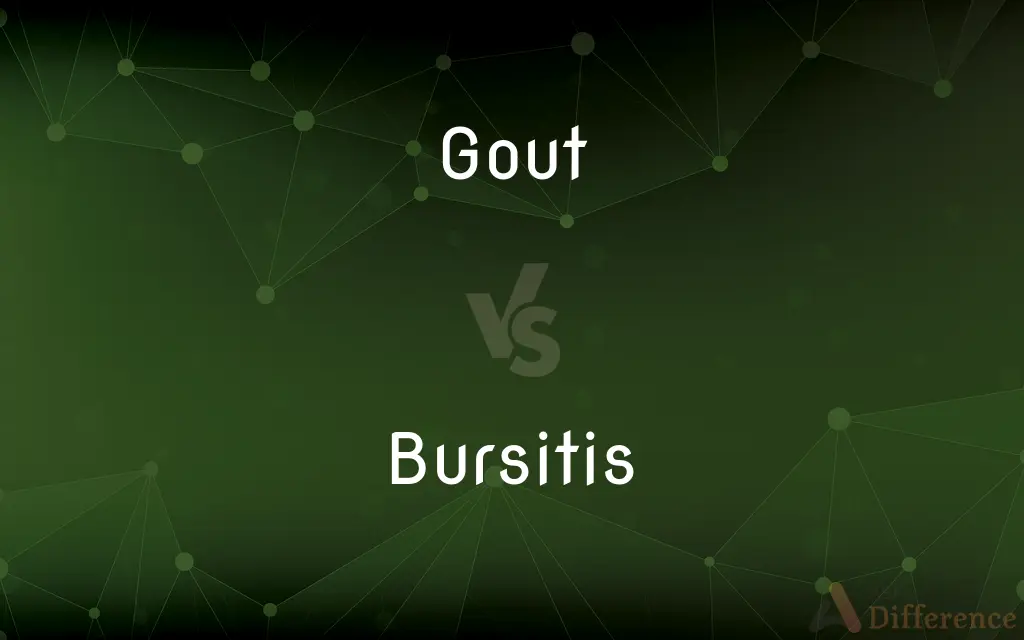Gout vs. Bursitis — What's the Difference?
By Tayyaba Rehman & Urooj Arif — Updated on March 24, 2024
Gout is a form of inflammatory arthritis caused by excess uric acid, leading to painful joint swelling, primarily in the big toe. Bursitis involves inflammation of the bursae, fluid-filled sacs cushioning bones and tissues, causing pain and discomfort.

Difference Between Gout and Bursitis
Table of Contents
ADVERTISEMENT
Key Differences
Gout results from the buildup of uric acid crystals in the joints, causing intense pain, redness, and swelling, often affecting the base of the big toe. Bursitis, on the other hand, is caused by the inflammation of the bursae, which can result from repetitive motion or pressure, leading to pain and limited movement in joints like the shoulder, elbow, hip, or knee.
While gout attacks can occur suddenly, often waking individuals in the night with the sensation of the affected joint being on fire, bursitis tends to develop more gradually or can flare up suddenly due to injury. Gout's pain is known for its severity and can be triggered by dietary factors, whereas bursitis pain is more constant and exacerbated by movement of the affected joint.
Gout is often managed through medication to lower uric acid levels, dietary changes, and lifestyle modifications to prevent future attacks. Treatment for bursitis typically includes rest, ice, and anti-inflammatory medications, with a focus on relieving inflammation and preventing recurrence through physical therapy or changes in activity patterns.
Risk factors for gout include diet, obesity, certain medications, and genetics, highlighting its systemic nature. Conversely, bursitis risk factors are more associated with local joint usage, such as repetitive movements or prolonged pressure on the joint, indicating its mechanical cause.
Despite their differences, both conditions can lead to significant discomfort and impaired mobility, underscoring the importance of medical diagnosis and appropriate treatment. Recognizing the distinct causes and treatments for gout and bursitis is crucial for effective management and recovery.
ADVERTISEMENT
Comparison Chart
Cause
Buildup of uric acid crystals
Inflammation of the bursae
Commonly Affected Areas
Base of the big toe, feet, ankles
Shoulders, elbows, hips, knees
Symptoms
Intense pain, redness, swelling
Pain, swelling, limited movement
Onset
Sudden, often at night
Gradual or sudden due to injury
Treatment
Medication, diet, lifestyle changes
Rest, ice, anti-inflammatory medications
Risk Factors
Diet, obesity, medication, genetics
Repetitive movements, prolonged pressure
Pain Characteristic
Severe, triggered by dietary factors
Constant, exacerbated by movement
Management Focus
Lowering uric acid, preventing attacks
Relieving inflammation, preventing recurrence
Compare with Definitions
Gout
A form of inflammatory arthritis.
After years of ignoring his diet, he developed gout, making even walking a painful ordeal.
Bursitis
Commonly affects shoulders, elbows, and hips.
She felt a constant ache in her shoulder, a symptom of bursitis from playing tennis.
Gout
Often affects the big toe.
He woke up in the middle of the night with his big toe swollen and in intense pain, a classic sign of gout.
Bursitis
Inflammation of the bursae.
Years of typing led to her developing bursitis in her elbow, making each keystroke painful.
Gout
Characterized by sudden pain.
The sudden, unbearable pain in her foot was the first indication she had gout.
Bursitis
Can be caused by repetitive motion.
As a professional painter, the repetitive motion of brushing eventually caused him bursitis.
Gout
Caused by excess uric acid.
Her gout was a direct result of her body's inability to process uric acid efficiently.
Bursitis
Treated with rest and anti-inflammatories.
Taking a break from running and using anti-inflammatory medication eased his bursitis symptoms.
Gout
Managed with diet and medication.
Changing his diet and taking the prescribed medication helped him manage his gout symptoms.
Bursitis
Symptoms include pain and limited movement.
Her bursitis made moving her lower body painful, limiting her ability to walk comfortably.
Gout
Gout is a form of inflammatory arthritis characterized by recurrent attacks of a red, tender, hot, and swollen joint. Pain typically comes on rapidly, reaching maximal intensity in less than 12 hours.
Bursitis
Bursitis is the inflammation of one or more bursae (fluid filled sacs) of synovial fluid in the body. They are lined with a synovial membrane that secretes a lubricating synovial fluid.
Gout
A spurt or splotch.
Bursitis
Inflammation of a bursa, especially in the shoulder, elbow, or knee joint.
Gout
(rare) A disease of wheat and cornstalks, caused by insect larvae.
Bursitis
(medicine) An inflammation of a bursa, most common in the shoulder, elbow or knee
Gout
(obsolete) taste; relish
Bursitis
Inflammation of a bursa.
Gout
(intransitive) To spurt.
Bursitis
Inflammation of a bursa; frequently in the shoulder
Gout
A disease of cornstalks. See Corn fly, under Corn.
Gout
Taste; relish.
Common Curiosities
Is bursitis a form of arthritis?
No, bursitis is not a form of arthritis; it's the inflammation of the bursae, not the joint itself or its cartilage.
What is the primary cause of gout compared to bursitis?
Gout is primarily caused by the accumulation of uric acid crystals in joints, while bursitis is caused by inflammation of the bursae due to repetitive motion or pressure.
Can gout and bursitis affect the same joints?
While both conditions can affect joints, gout commonly targets the big toe and lower body joints, whereas bursitis often affects the shoulders, elbows, and hips.
How long do gout attacks last?
Gout attacks can last from a few days to several weeks, with treatment and lifestyle changes helping to reduce their duration and frequency.
Is exercise good for managing gout and bursitis?
Moderate, low-impact exercise can help manage both conditions but should be tailored to avoid exacerbating symptoms.
What dietary changes can help manage gout?
Reducing intake of purine-rich foods, alcohol, and fructose can help manage gout by lowering uric acid levels.
Can bursitis lead to permanent damage?
If left untreated, bursitis can lead to chronic pain and limited mobility, but it typically doesn’t cause permanent damage.
Are there natural remedies for gout and bursitis?
For both conditions, natural remedies may include lifestyle and dietary changes, physical therapy exercises, and the use of cold or heat therapy to reduce inflammation.
How can I prevent gout and bursitis?
Preventing gout involves maintaining a healthy diet and weight, while preventing bursitis involves avoiding repetitive stress and injury to joints.
Can stress affect gout or bursitis?
Stress doesn't directly cause either condition, but it can exacerbate symptoms or lead to behaviors that increase risk.
How is the pain from gout different from bursitis?
Gout pain is often more intense and sudden, especially at night, while bursitis pain is more constant and aggravated by movement.
Can both gout and bursitis be cured?
Both conditions can be effectively managed with treatment, but they can recur or become chronic without ongoing management.
Do gout and bursitis affect men and women differently?
Gout is more common in men than in women, while bursitis can affect both genders, often related to specific activities or occupations.
Share Your Discovery

Previous Comparison
Monitoring vs. Evaluation
Next Comparison
Spring vs. HibernateAuthor Spotlight
Written by
Tayyaba RehmanTayyaba Rehman is a distinguished writer, currently serving as a primary contributor to askdifference.com. As a researcher in semantics and etymology, Tayyaba's passion for the complexity of languages and their distinctions has found a perfect home on the platform. Tayyaba delves into the intricacies of language, distinguishing between commonly confused words and phrases, thereby providing clarity for readers worldwide.
Co-written by
Urooj ArifUrooj is a skilled content writer at Ask Difference, known for her exceptional ability to simplify complex topics into engaging and informative content. With a passion for research and a flair for clear, concise writing, she consistently delivers articles that resonate with our diverse audience.















































